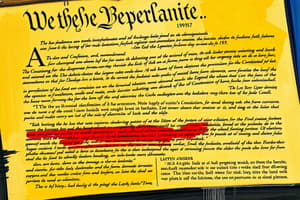Podcast
Questions and Answers
What was the primary aim of the Federalist Papers?
What was the primary aim of the Federalist Papers?
- To convince people to support the Articles of Confederation
- To convince people to ratify the Constitution (correct)
- To explain the powers of the Federal government
- To establish a clear system of checks and balances
Which of these is NOT a fear of the Anti-Federalists?
Which of these is NOT a fear of the Anti-Federalists?
- The lack of a strong, centralized government (correct)
- The new Constitution would not be effective
- A lack of a Bill of Rights to protect civil liberties
- The federal government having too much power
What was James Madison's contribution to the Federalist Papers?
What was James Madison's contribution to the Federalist Papers?
- He wrote 5 essays
- He wrote 51 essays
- He wrote 4 essays
- He wrote 29 essays (correct)
What was the main argument presented in Federalist #51?
What was the main argument presented in Federalist #51?
What was the outcome of the debates between the Federalists and the Anti-Federalists?
What was the outcome of the debates between the Federalists and the Anti-Federalists?
How many amendments have been made to the Constitution since it was ratified?
How many amendments have been made to the Constitution since it was ratified?
What year did the Anti-Federalists agree to support the ratification of the US Constitution?
What year did the Anti-Federalists agree to support the ratification of the US Constitution?
What year was the Bill of Rights added to the US Constitution?
What year was the Bill of Rights added to the US Constitution?
What is the main function of Judicial Review?
What is the main function of Judicial Review?
Which of these is an example of a SUBSTANCE Amendment to the Constitution?
Which of these is an example of a SUBSTANCE Amendment to the Constitution?
What does the phrase 'If a law contradicts the Constitution, it is void' mean?
What does the phrase 'If a law contradicts the Constitution, it is void' mean?
What did Justice John Marshall do in the Marbury v. Madison case?
What did Justice John Marshall do in the Marbury v. Madison case?
Which of the following represents a PROCESS Amendment to the Constitution?
Which of the following represents a PROCESS Amendment to the Constitution?
How does the concept of Judicial Review ensure that the Constitution remains a guide for the government?
How does the concept of Judicial Review ensure that the Constitution remains a guide for the government?
What is a constitution?
What is a constitution?
What is the main idea behind constitutionalism?
What is the main idea behind constitutionalism?
What is the relationship between the Declaration of Independence and the US Constitution?
What is the relationship between the Declaration of Independence and the US Constitution?
What were the main issues debated at the Constitutional Convention in 1787?
What were the main issues debated at the Constitutional Convention in 1787?
What was the 'Great Compromise' designed to resolve?
What was the 'Great Compromise' designed to resolve?
What does "fragmentation of power" mean in the context of the US Constitution?
What does "fragmentation of power" mean in the context of the US Constitution?
What was Shay's Rebellion, and how did it influence the drafting of the Constitution?
What was Shay's Rebellion, and how did it influence the drafting of the Constitution?
What is the "3/5 Compromise" and what was its significance?
What is the "3/5 Compromise" and what was its significance?
Flashcards
Constitution
Constitution
The basic framework of a government, outlining its structure, powers, and rules for decision-making.
Constitutionalism
Constitutionalism
The belief in limiting government power through a written document, like a constitution.
Declaration of Independence
Declaration of Independence
A document that declared the 13 American colonies independent from British rule in 1776.
Articles of Confederation
Articles of Confederation
Signup and view all the flashcards
Shay's Rebellion
Shay's Rebellion
Signup and view all the flashcards
Constitutional Convention
Constitutional Convention
Signup and view all the flashcards
Separation of Powers
Separation of Powers
Signup and view all the flashcards
Great Compromise
Great Compromise
Signup and view all the flashcards
Checks and Balances
Checks and Balances
Signup and view all the flashcards
Federalists
Federalists
Signup and view all the flashcards
Anti-Federalists
Anti-Federalists
Signup and view all the flashcards
Federalist Papers
Federalist Papers
Signup and view all the flashcards
Bill of Rights
Bill of Rights
Signup and view all the flashcards
Ratification
Ratification
Signup and view all the flashcards
Legislative Power
Legislative Power
Signup and view all the flashcards
Executive Power
Executive Power
Signup and view all the flashcards
Constitutional Amendment
Constitutional Amendment
Signup and view all the flashcards
Judicial Review
Judicial Review
Signup and view all the flashcards
Marbury v. Madison
Marbury v. Madison
Signup and view all the flashcards
Ratification of the Constitution
Ratification of the Constitution
Signup and view all the flashcards
Study Notes
US Government Course: Module 1
- The course covers the US Constitution.
- Key figures like John Adams and Theodore Roosevelt are mentioned as sources on constitutionalism.
- Vocabulary:
- Constitution: The legal structure of a political system, defining governmental bodies, their powers, member selection, and decision-making rules.
- Constitutionalism: The belief in limiting governmental power through a written charter.
- Political Context of the US Constitution:
- Relationship with Great Britain and King George: Explored along with the Declaration of Independence (1776).
- Declaration of Independence: Discussion of the 4 major themes.
- Articles of Confederation (1777-1787): Identified as a system of governing followed before the Constitution, and the needs to revise it (5 main provisions discussed).
- Shays' Rebellion (1786-1787): A significant event leading up to the Constitutional Convention.
- Constitutional Convention (1787):
- Purpose: To revise the Articles of Confederation.
- Delegates: 55 delegates from 12 states attended.
- Agreements:
- Republic Formation: Delegates' aim to establish a republic.
- National Government Supremacy: Establishing the national government as supreme over the states.
- Three Branches: Establishment of three branches of government (Legislative, Executive, Judicial) with shared power.
- Separation of Powers: Borrowed concept from the Iroquois Confederacy, particularly in the context of New York.
- Map: A map of the 13 original colonies in 1774 is included as part of the background.
- Conflicts:
- Big States vs. Small States: Debate over representation.
- Slavery (North vs. South): Further debate over the inclusion and representation of slaves in government.
- Great Compromise: Resolving the representation issue in Congress (House = proportional, Senate = equal)
- 3/5 Compromise: Counting slaves as 3/5 of a person for representation in the House of Representatives, largely benefiting the Southern states.
- Fragmentation of Power:
- Divide of Power: The national (federal) government's power is divided among three branches.
- State vs. Federal: The balance of power between state and federal governments and the relationship between the two is described.
- Checks and Balances: A system where each branch has the power to limit the actions of the other two.
- The Signing of the Constitution: Image included.
- Fight for Ratification: Explains the Federalists versus Anti-Federalists debate.
- Federalist Papers: Describes the historical context and importance of these papers from a perspective of promoting the Constitution.
- The Debate: Describes the Federalists' arguments in favor of a stronger central government, and the Anti-Federalists' opposition (fears about too much government power and the absence of a Bill of Rights).
- Federalist #51 (by Madison): Explains the importance of separating powers.
- Result of the Debate: The Anti-Federalists agreed to ratify the Constitution in 1789, after the Federalists agreed to add a Bill of Rights in 1791.
- Amendments: Focuses on the importance and the creation of the first ten amendments as being the Bill of Rights.
- Amendments: Explains the ways that the Constitution has been amended (substance and processes.)
- Judicial Review (Marbury v. Madison 1802): The Supreme Court's power to declare laws unconstitutional established.
- Conclusion: A brief review including a concluding quote.
Studying That Suits You
Use AI to generate personalized quizzes and flashcards to suit your learning preferences.




